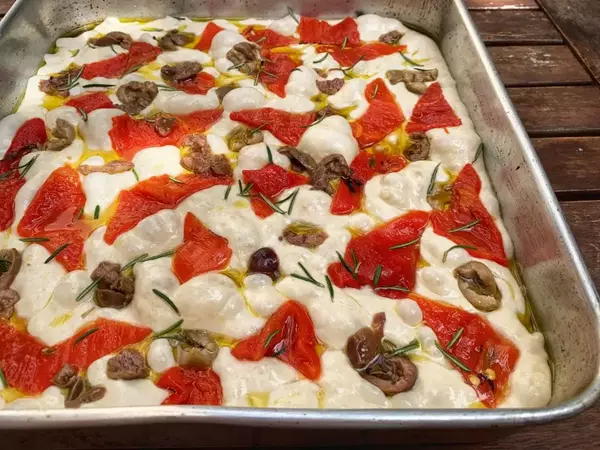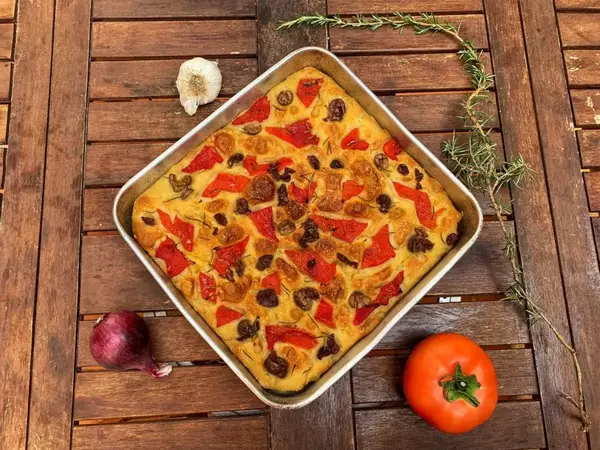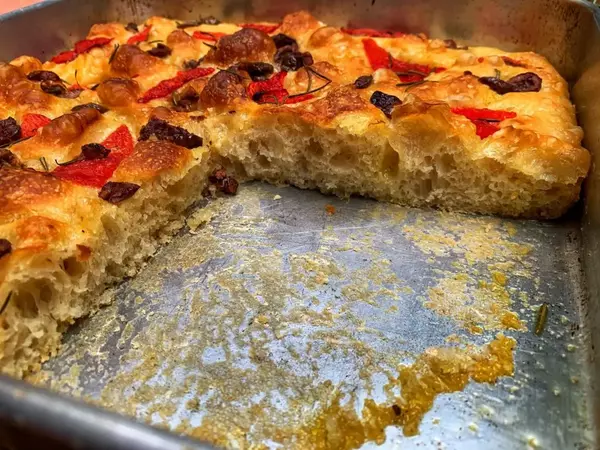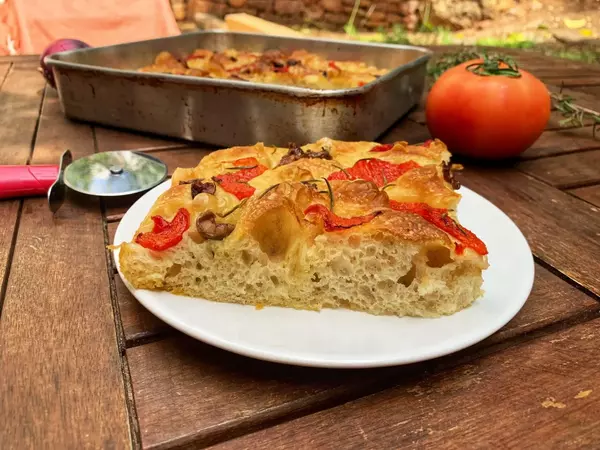This fluffy Focaccia will make you feel like you’re biting into a pillow: airy, soft and light – just lovely! Focaccia is a wonderful thing, so simple and yet so good! And the practical thing is, you can top it with whatever ingredients you feel like or have on hand! This fluffy Focaccia is a delicious main course or a great side dish to a Mediterranean meal and on top of that so easy to make!
Why you should use Poolish for the Focaccia dough
Poolish is a pre-fermented dough that is prepared with water, flour and a small amount of yeast. The flour-water ratio is 1:1, e.g. 100 grams of flour are mixed with 100 grams of water. The poolish gives the dough more elasticity and also a slightly sour, distinctive aroma.
For this recipe you should allow the dough to rest for at least 24 hours. For those who are not in a hurry, you can let the dough rest in the fridge for up to 48 hours. For this recipe you only need your hands and some time! The dough is a no-knead dough, made only by folding and resting the dough (also called stretch & fold technique).
The recipe makes one Focaccia (for a tray of about 25cm x 36cm)
Ingredients for the Poolish
- 330 gr flour (preferably a Tipo 00 flour with as high a protein content (>12 gr))
- 330 gr water
- 1 gr dry yeast (or 3 gr fresh yeast)
Mixing the Poolish
- Pour the water into the bowl, add the dry yeast and mix briefly with a spoon.
- Now slowly add the flour to the yeast-water and mix it with the spoon. Make sure that no dry flour remains.
- When all the flour is incorporated, the dough will resemble a shapeless, moist and sticky mass (see picture below).
- Now cover the bowl (with a lid or cling film), let it rest at room temperature for an hour and then put it in the fridge for at least 16 hours or up to 24 hours.
Ingredients for the main dough
- 100% poolish
- 170 gr flour (preferably a Tipo 00 flour with the highest possible protein content (>12 gr))
- 13 gr fine salt
Mixing the main dough
- Place the poolish and the flour in a bowl and mix roughly with a spoon until the flour is completely incorporated.
- Add the salt to the dough and also mix coarsely with the spoon.
- Cover the dough (e.g. with cling film or lid) and let it rest for 1 hour at room temperature.
- Then rub the work surface with a little water and put the dough on it. The dough will certainly still resemble a wet and sticky mass at this point – but don’t worry, it will change! Now wet your hands with a little water and pull the dough from all four sides (top, left, right, bottom) one by one from the bottom to the top and fold it in the middle. The dough may still look like an unflowy mass now, but just be patient! Cover the dough with the bowl and let it rest for 30 min.
- Then repeat the whole thing, again pulling the dough from all four sides one by one from the bottom to the top and folding it in the middle. You may already notice that the dough has become a bit more stable after these 30 min.
- Now cover the dough with the bowl and let it rest again for 30 min. After these 30 minutes, repeat the folding of all four sides.
- In total you can plan 4 to 6 folding and resting units, that is 2 to 3 hours. With each folding and resting session, you will notice that the dough becomes more and more stable and firm – a sign that the gluten network is forming.
- After the last folding unit, you should be able to shape the dough into a round ball (you can also see how to shape the dough round in this video). Lightly oil a sealable bowl, place the dough ball inside and cover.
Resting the dough
- Now let the dough rest in the fridge for at least 12 or up to 24 hours.
- Then rub the work surface with a little water, put the dough on it and form it into a ball again (e.g. with the folding method or as in this video).
- Then rub the pan in which the Focaccia is to be baked generously with olive oil on all sides and put the dough ball in.
- Rub the surface of the dough with a little olive oil and cover the pan (e.g. with cling film or a lid).
- Now let the dough rest for 2 hours at room temperature or refrigerate for up to 24 hours.
Note for the refrigerator option: after the 24 hours, let it rest at room temperature for 2 hours and cover it, then proceed with the “Topping the Focaccia” step. - After the 2 hours, the dough should have increased in volume. Moisten your hands a little and prod out the dough to the edges of the tray using your fingers.
Topping the Focaccia
When topping, you can give free rein to your creativity, or you can also use what you have at home. Popular are for example cherry tomatoes, dried tomatoes, olives, onions. I opt for this topping:
- Grilled peppers
- Olives
- Rosemary
- Coarse sea salt (quantity upon own taste)
- Olive oil
- Water
Press the peppers and olives into the dough so that they are slightly poking above the surface. Then sprinkle with rosemary and sea salt. Mix 3 tablespoons of olive oil and 3 tablespoons of water in a small bowl and pour over the dough (if needed, you can also add more or less of the olive oil-water mixture). Let the dough rise again for one hour at room temperature.

Baking the Focaccia
- Preheat the oven to 200 degrees Celsius top and bottom heat.
- Put the pan with the Focaccia in the oven and bake for 30 min (depending on your own preference and degree of browning also a little shorter or longer).
This is what the finished fluffy Focaccia looks like


Discover more
You’d like to start making pizza right away, but you’re wondering where to start? We have summarized the most important information on the following page for you.
Thanks for reading! I hope this Focaccia recipe was valuable to you. If you have any unanswered questions, feel free to let me know in the comments. I’d appreciate it if you could share this article with your friends.
Julia


This looks fabulous (and spongy! :-D).